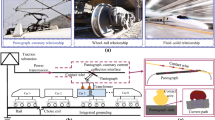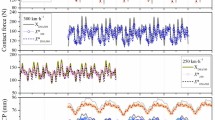Abstract
High speed trains receive traction electrical energy from a high-voltage catenary via a pantograph catenary system (PCS). As the velocity of trains increases, the traditional PCSs face significant challenges, such as strong aero resistance under high-speed conditions, severe electrochemical corrosion caused by poor contact between the pantograph strip and the catenary, harmful wear both on the pantograph strip and the contact wire produced by high-speed sliding friction between them, etc. The effectiveness and reliability of the PCS has a direct impact on the performance and safety of the HTS power supply. In order to alleviate some of these bottleneck effects related to the operation of the currently used PCSs, especially under high-speed conditions, this paper proposes a novel configuration where rotatable pantograph rollers replace the currently used pantograph strips. As the sliding friction is now replaced by rotating friction, this has numerous benefits, such as less friction heat, better heat dispersion and improved catenary-tracking performance. Moreover, should the whole system be modularized, it could adapt to different levels of traction power through adjusting the number of rollers.






















Similar content being viewed by others
References
Zhang W, Shen Z, Zeng J (2013) Study on dynamics of coupled systems in high-speed trains. Veh Syst Dyn Int J Veh Mech Mobil 51(7):966–1016
Bouchoucha A, Chekround S, Paulmier D (2004) Influence of the electrical sliding speed on friction and wear processes in an electrical contact copper-stainless steel. Appl Surf Sci 223:330–342
Midya S, Bormann D, Schutte T, Thottappillil R (2009) Pantograph arcing in electrified railways—Mechanism and influence of various parameters—Part II: with AC traction power supply. IEEE Trans Power Del 24(4):1940–1950
Yang HJ, Chen GX, Gao GQ, Wu GN, Zhang WH (2015) Experimental research on the friction and wear properties of a contact strip of a pantograph–catenary system at the sliding speed of 350 km/h with electric current. Wear 332–333:949–955
Nagasawa H, Kato K (1988) Wear mechanism of copper alloy wire sliding against iron-base strip under electric current. Wear 216(2):179–183
Ding T, Chen GX, Bu J et al (2011) Effect of temperature and arc discharge on friction and wear behaviors of carbon strip/copper contact wire in pantograph–catenary system. Wear 271(1):1629–1636
Nituca C (2013) Thermal analysis of electrical contacts from pantograph–catenary system for power supply of electric vehicles. Electric Power Syst Res 96:211–217
Guo FY,Jia W, Chen ZH, et al. (2010) Experimental research on current-carrying and friction characteristics of sliding electrical contact, in Proceedings of 25th international conference on electrical contacts and 56th IEEE holm conference on electrical contacts, pp. 424–429
Wu G, Wei W, Gao G, Wu J, Zhou Y (2016) Evolution of the electrical contact of dynamic pantograph-catenary system. J Mod Trans 24(2):132–138
Musolino A (2005) Finite-element method/method of moments formulation for the analysis of current distribution in rail launchers. IEEE Trans Magn 41(1):387–392
Hsieh K (1995) A Lagrangian formulation for mechanically, thermally coupled electromagnetic diffusive processes with moving conductors. IEEE Trans Magn 31(1):604–609
Wang ZY, Guo FY, Wang XL, et al. (2015) Experimental research on radiated electromagnetic noise of pantograph arc, 61st IEEE holm conference on electrical contact, pp. 256–261
Gao S, Wang Y, Liu Z, Mu X, Huang K (2017) Thermal distribution modelling and experimental verification of contact wire considering the lifting or dropping pantograph in electrified railway. IEEE Transactions on Transportation Electrification 2(2):256–265
Ge X, Liu W, Yang Z, Wang Y (2014) The study on electrical temperature characteristics of high-speed pantograph. In Proceedings of the 2014 IEEE transportation electrification conference and expo (ITEC Asia-Pacific), pp. 1–4
Acknowledgements
This work was supported in part by the National Natural Science Foundation for Distinguished Young Scholars of China under Grant 51707166, and in part by the Scientific Research Project of Central University Grant 2682018CX16 as well as the Sichuan Science and Technology General Project Grant 2019YJ0213.
Author information
Authors and Affiliations
Corresponding author
Additional information
Publisher's Note
Springer Nature remains neutral with regard to jurisdictional claims in published maps and institutional affiliations.
Rights and permissions
About this article
Cite this article
Xiao, S., Luo, Y., Wu, J. et al. An Investigation into the Characteristics of a Novel Rotatable Pantograph Catenary System for High-Speed Trains. J. Electr. Eng. Technol. 16, 1721–1730 (2021). https://doi.org/10.1007/s42835-021-00664-1
Received:
Revised:
Accepted:
Published:
Issue Date:
DOI: https://doi.org/10.1007/s42835-021-00664-1




